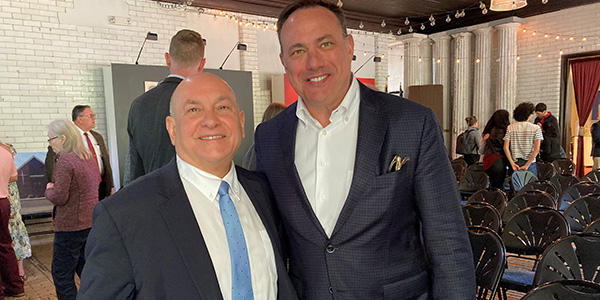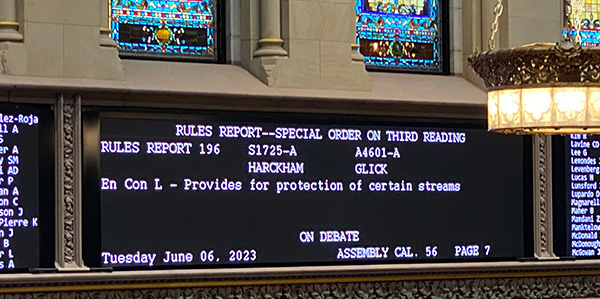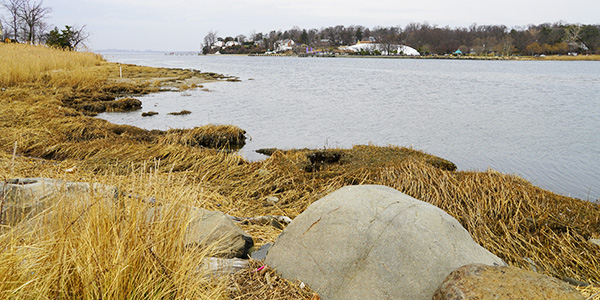
This blog was updated from our end-of-session press release, which we issued on Saturday, June 10.
It was the middle of Thursday afternoon, on what was intended to be the final day of the legislative session in New York, when Governor Kathy Hochul stood beside several of her commissioners and acknowledged that everywhere across the state – except the Adirondacks region – the air was “unhealthy.”
“We are taking climate change so seriously in the state of New York,” said Gov. Hochul.
Meanwhile, the midday skies in New York City smoldered orange.
Two days later, the legislative session ended. Another deadline missed in a session defined by them. And while there were several priority pieces of legislation we pushed to pass that did not – including the Living Shorelines bill, which, despite the extended session, still ran out of time – the actions of the legislature, for the most part, provided modest backup for the Governor’s words.
Two bills passed in both the Senate and the Assembly will expand protections of waters and wetlands in the Long Island Sound watershed and across the state. Class C Streams (S1725/A4601) changes the classification of certain waterways – specifically, ones that had been used for fishing and boating but not for primary contact activities, such as swimming, nor for drinking – ensuring they will now be provided the same New York Department of Environmental Conservation protections afforded to all streams. And Freshwater Wetlands Protections (S5957/A5949) provides local governments the ability to decide whether to implement tighter restrictions than the state’s regarding the application of pesticides in designated wetlands areas within their jurisdictions. Local governments cannot create laws weaker than the DEC standards, but they will be able to expand restrictions to their wetlands.

That these bills passed in the final week of session is crucial. In late May, the Supreme Court diminished the protective reach of the Clean Water Act, leaving significant portions of our nation’s wetlands vulnerable to pollution, development, and destruction of habitat. The devastating decision to strip away federal protections made it urgent to strengthen state protections.
“It is more important than ever that states expand their protections of all waters and wetlands,” said David Ansel, our vice president of water protection. “We are encouraged by the actions taken this week by the legislature to pass bills that will protect our region and benefit tens of thousands of miles of streams and more than two million acres of wetlands across New York State. We appreciate the commitment and leadership of the bills’ sponsors: Senator Pete Harckham and Assemblymember Deborah Glick on Class C Streams, and Senator Harckham and Assemblymember Chris Burdick on the wetlands protections.”
Now, we will work to ensure they are signed into law. Both bills had passed both houses last session, too, only to become two of the 165 vetoes issued by Governor Hochul last December. We’ll soon see what “taking climate change so seriously” means in Albany.
Another bill that passed both houses – though it didn’t clear the Assembly until Friday, the first bonus day of the session – was a Flood Disclosure (S5400/A1967) bill we supported. A companion to the disclosure bill passed last session that protects renters, this bill protects homebuyers by updating and expanding the disclosure statement and holds sellers liable for failing to disclose a property’s flood history prior to sale. We appreciate the sustained effort of sponsors Senator Brad Hoylman-Sigal and Assemblymember Robert Carroll to get this bill passed.
“As heavy rains and flooding become more frequent and severe due to climate change, homebuyers across New York must have the information they need in order to protect their assets and their families,” said David. “We applaud the Assembly and Senate for giving homebuyers the right to know flood risks, just as New York State gave these rights to tenants last year.”
Without question, the biggest disappointment of the session was that one of our top legislative priorities in the last two sessions, Living Shorelines (S5186A/A5221A), was not given a vote in the Assembly. It passed the Senate on Monday – for a second time, actually; this bill passed the Senate on March 22, went to the Assembly, was recalled from the Assembly on May 30, amended, and then passed again. And though it was listed on the Assembly calendar for at least the last three days of the session, it was never called.
The Living Shorelines bill requires the New York State Department of Environmental Conservation to establish nature-based solutions (such as coastal marshes, dunes, shellfish reefs) as the preferred option for tidal shoreline management. It would prioritize green infrastructure over gray structures to better protect coastal communities from erosion, storm surge, and sea level rise. Nature-based features have the ability to adapt to changing conditions, making them an essential tool for strengthening resiliency in the face of climate change. We will continue to prioritize legislation that would create opportunities to integrate living shorelines into the coastline of Long Island Sound, similar to our ongoing work on the Big Rock Wetland Restoration project in Queens.

“We are disappointed this bill did not come to a vote in the Assembly, after passing in the Senate for a second straight year,” said Katie Friedman, our New York ecological restoration program manager. “With increased storms and sea level rise threatening our coastline, New York State must prioritize the use of living shorelines as the best solution to both protect our coastal communities and restore critical habitat. We thank Senator Shelley Mayer, Assemblymember Steve Otis, and their co-sponsors – Senators Andrew Gounardes, Rachel May, and Jessica Ramos, and Assemblymembers Michael Benedetto, Jo Anne Simon, and Grace Lee – for their hard work on this bill. We look forward to continuing to work on passing this important legislation in the next session.”
We were similarly disappointed that two prominent bills did not find their way to the finish line, failing to be brought to a vote in one or both chambers.
Despite the best efforts of a coalition that included an Avenger, the Packaging Reduction and Recycling Infrastructure Act (S4246A/A5322A) idled in committee in both the Senate and the Assembly. The bill, sponsored by the chairs of the Environmental Conservation committees in both houses – Senator Harckham and Assemblymember Glick – would have cut plastic packaging in half over the next 12 years, eliminated many toxic pollutants, including PFAS, from packaging materials, and shifted the cost and burden of managing the end of life of packaging materials from the taxpayer to the producer. This would protect people and wildlife alike by cutting down on entanglement in and ingestion of plastics, and by reducing toxins in our water and soil.
“We feel very strongly this bill represents a huge step toward addressing the massive problem of plastic pollution,” David Ansel said. “Producers have the power to affect our environment in ways the average consumer doesn’t; they should be responsible for what they put in their packaging materials and the cost of cleaning it up.”
Likewise, the NY HEAT (Home Energy Affordable Transition) Act (S2016A/A4592), was passed in the Senate on Tuesday but did not receive a vote in the Assembly.
“New York missed a golden opportunity to cut climate pollution and support families with the NY HEAT Act,” said Alex Rodriguez, our environmental justice specialist. “It would have eliminated subsidies for new gas hookups and enabled neighborhood-scale building decarbonization. Importantly, it would have reduced energy bills for low- and moderate-income households. Families would have paid no more than 6% of their income for energy. It’s disappointing to see this opportunity slip by and we hope to see it revisited next session, in addition to the Energy Efficiency, Equity, and Jobs Act, which would have deployed funding for cost-saving and emissions-reducing retrofits in communities of low wealth and communities of color.”
Perhaps the biggest win for climate policy came during the budget-building portion of the session, which ran more than a month long. In May, when lawmakers passed the Governor’s $229 billion budget for 2024, they included a plan to transition all new buildings in the state from natural gas to electric power, the All-Electric Buildings Act. This will decrease greenhouse gas emissions and air pollution by phasing out the construction of new buildings with fossil fuel hookups. It will go into effect for new single-family residences and low-rise buildings six stories or less built after 2023 and for all remaining buildings in 2027.
Another of the most significant victories for our region this session was a small provision tucked away in the biggest budget in New York State history. It allows Suffolk County to approve a November referendum, empowering local voters to determine whether to enact a 1/8-cent county sales tax increase that would fund the creation of a unified wastewater management district. That would be a water quality game-changer in a county where so many residences and business are not currently connected to a sewer system. We will be working to ensure the Suffolk County Water Quality Restoration Fund gets on the ballot, and that the voters of Suffolk County have a chance to be heard and protect their groundwater and the Sound.
Looking back at the 2023 legislative session, it seems that the environmental investments included in the state Budget will have a greater impact than much of the legislation that followed. The budget deal included $500 million for the Clean Water Infrastructure Act, $400 million for the Environmental Protection Fund – both of which we went to Albany to advocate for on Environmental Lobby Day – funding for increased DEC staffing and to implement the $4.2 billion Environmental Bond Act, passed by referendum in November, which probably represents the greatest reason to celebrate over the past eight months. The first Bond Act funds are ready to flow; the influx of Bond Act funding means that two state water grant programs – the Water Infrastructure Improvement Act and Intermunicipal Grants – has $425 million available this year.
Now that the session is over, we’ll continue to work with our partners in the legislature and other environmental leaders to prepare for the next session, which gets underway in a little more than 6.5 months. One thing we’ll be watching is the evolution of Gov. Hochul’s Cap-and-Invest plan to reduce greenhouse gas emissions. Since being introduced in the Governor’s Proposed Budget, Cap-and-Invest remains a work in progress. It is in the regulations development stage, and we remain optimistic about the prospect of New York establishing the first economy-wide cap-and-invest program in the northeast, a groundbreaking policy the rest of the region could follow.
